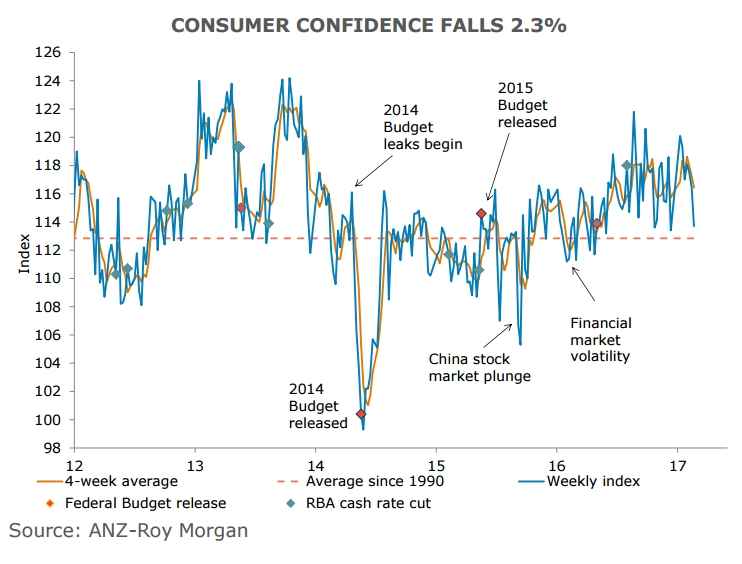At the board meeting held on February 7, the Reserve Bank of Australia (RBA) policymakers voted to leave the cash rate unchanged at 1.50 percent as they judged that it would be consistent with sustainable growth in the economy and achieving the inflation target over time. Minutes of the February RBA board meeting were released on Tuesday. The RBA continued with its broadly upbeat commentary in the minutes.
The RBA downplayed the contraction in GDP in the September quarter and said that Australia’s economic slowdown in Q3 2016 was likely temporary. The RBA noted that the nation’s third quarter contraction reflected some temporary factors, including disruptions to coal supply and bad weather. Australia subsequently recorded a large trade surplus, aided by resource exports in the following three months.
"Australia's low-cost producers of iron ore were expected to increase output further and the ramp-up in liquefied natural gas production was expected to make a significant contribution to output growth," the central bank said.
The bank forecast growth to pick up to around 3 percent in the year-ended terms later in 2017, and to remain above estimates of potential growth over the rest of the forecast period. Policymakers expect the underlying inflation to pick up gradually, largely reflecting the rising unit labor costs and the diminishing spare capacity. Further, the central bank predicts that rising resource exports in a more positive global environment will spur growth in Australia as the drag from falling mining investment wanes.
However, cautious comments prevailed on the labor market. The RBA warned subdued growth in household income was likely to constrain consumption growth. The central bank said spare capacity in the labour market will likely persist and consumption growth could be limited by subdued income levels. December quarter wages figures are due on Wednesday, which economists expect will continue to show annual growth sub-two percent and the lowest in at least two decades.
Earlier today the ANZ-Roy Morgan confidence index dropped by a further 2.3 percent to its lowest level since December. Sharp decline was seen in views toward current finances and also views on economic conditions over the next five years. Aussie left unimpressed after RBA minutes. AUD/USD down 0.33 percent on the day, trading at 0.7661 at around 1140 GMT. We see a potential 'Bullish Gartley' pattern on hourly charts raising scope for near-term downside. Completion of the 'Bullish Gartley' could open possibilities for long.



 Will global oil supply be at risk if Iran and Israel pull the Middle East into war?
Will global oil supply be at risk if Iran and Israel pull the Middle East into war?  Fallout: an expertly crafted TV adaptation that manages to incorporate some of the best elements of gameplay
Fallout: an expertly crafted TV adaptation that manages to incorporate some of the best elements of gameplay  RBA's latest forecasts are grim. Here are 5 reasons why
RBA's latest forecasts are grim. Here are 5 reasons why  Extraordinary Vietnam fraud case exposes the inherent vulnerabilities of banks
Extraordinary Vietnam fraud case exposes the inherent vulnerabilities of banks  Governments have been able to overrule the Reserve Bank for 80 years. Why stop now?
Governments have been able to overrule the Reserve Bank for 80 years. Why stop now?  The Federal Reserve held off hiking interest rates
The Federal Reserve held off hiking interest rates  History for sale: what does South Africa’s struggle heritage mean after 30 years of democracy?
History for sale: what does South Africa’s struggle heritage mean after 30 years of democracy?  Inflation is slowly falling, while student debt is climbing: 6 graphs that explain today’s CPI
Inflation is slowly falling, while student debt is climbing: 6 graphs that explain today’s CPI  What is ‘techno-optimism’?
What is ‘techno-optimism’?  Impact of Iran-Israel conflict on Stocks, Gold and Bitcoin
Impact of Iran-Israel conflict on Stocks, Gold and Bitcoin  Think the RBA will lift rates on Melbourne Cup day? Don't bet your house on it
Think the RBA will lift rates on Melbourne Cup day? Don't bet your house on it  How breakdancing became the latest Olympic sport
How breakdancing became the latest Olympic sport  Industry shutdowns are messy and painful: 4 lessons Australia’s coal sector can learn from car-makers about bowing out
Industry shutdowns are messy and painful: 4 lessons Australia’s coal sector can learn from car-makers about bowing out 































